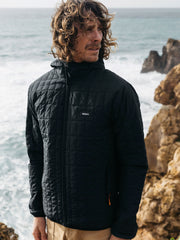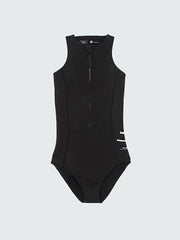The Hand Built Home: In Conversation
09.29.20
4 min read
The Cabin is well hidden. Set in a small patch of woodland, the flowing lines of its waney edged timber cladding blend with the surroundings so that the building looks as if it has always been there. Alongside the cabin sits a small hut (the poop shack, as I discovered later), a wood store and a small fire pit with log seating around it. Around the back of the cabin I can just see a small veg garden, with some chard and kale still growing.
On entering, tea is offered and instantly there is a sense of homeliness that makes me feel comfortable and welcomed. Sam and Meg are pottering, squeezing in some chores before my expected arrival. The inside has just as much character as the exterior, if not more. Whole branches act as beams and rafters, an integral part of the building’s design. Instruments hang on the walls and the shelves are lined with books and records. The table has been placed by the patio doors ready for our conversation, looking out on the field behind this little homestead.
As we sit down, my eyes are still darting around, trying to take it all in and marvelling at the details and craftmanship. My first question is pretty basic. Why? What was the impetus behind embarking on such a huge project?
“It definitely started as a freedom thing that then turned into a sustainability thing,” explains Sam. “I’ve always had an interest in alternative living, trying to live smaller and more sustainably. I wasn’t earning much money so I just wanted a way that I could live as low cost and low impact as possible.”
Having previously lived on a boat, Sam converted a van that became his home for three years. Building the cabin, he says, was a natural progression. “It’s quite hard to explain the feeling that comes with it,” he muses, “There’s definitely a unique relationship that you have to a place you’ve built yourself. There’s a certain energy that you get back from it when you’ve been through every stage – finding the trees, felling them, dragging them out of the woods, taking all the bark off each one…”
Looking around it’s easy to see that relationship. This is no kit-built garden shed. Every inch displays the subtle signs of a deeply engaged craftsman; from the functional details, to the flowing lines of entire branches that make up its frame.
“These big roundwood beams that hold everything up,” Sam points up to the structural beams above our heads, “I actually remember being in the woods and looking up to try and find the right size and thickness and straightness for what was going to work. The shape of the trees has dictated the shape of the cabin in a lot of ways. Nothing is completely plumb or level, it’s all evolved into these weird shapes.”
“It kind of acts like a tree as well,” Meg chimes in, “Like in the winter storms, you know how a tree will sway and creak? Well, it definitely moves a bit and almost acts like a real tree.”
So what must it be like to actually live here? The idea of off-grid living has become romanticised in recent years, and though on the surface this may seem idyllic, there must surely be challenges?
“Well, firstly it’s not off grid,” Sam corrects me. “We do have mains power and mains water, but apart from that yeah – we have gas canisters for the cooker and we use the log burner to heat it.”
Meg goes into a bit more detail, “I think that when you’re living somewhere and it’s your daily routine, it doesn’t feel any harder than somewhere else. It just becomes your normal. There are definitely moments. You know; winter storm, middle of the night, you need a wee – well you have to go outside. That can suck a bit, but it actually happens so rarely. It’s funny because when you do implement something it quickly becomes normal. We got our composting going about a year ago and now, when I go to friend’s houses and they don’t compost, I’m like, “What are you doing?!? That’s a really valuable resource!”
Sam chuckles, “She takes a tupperware with us whenever we go to friend’s houses now…”
There are definitely challenges, but Sam and Meg’s approach seems to be realistic positivity, even in the face of rather major inconveniences, such as burst water pipes. “When stuff does go wrong we always try and remember that plumbing breaks everywhere,” reasons Meg, “Even if you live in a mansion you’re going to get plumbing issues. It’s actually fairly normal. You have to try and hold onto things lightly. Security is a bit of an illusion…”
Sam chimes in and adds, “At the end of the day, even if you have your mortgage paid off and you’re in an amazing job, one of you could get sick or your job could disappear overnight, or the house could burn down!” For them, it’s all about the choices we make and how we want to live, as Sam goes on to explain.
“We all think we need so much, but you actually don’t,” he argues, “I even feel like in here, we have so much stuff that we don’t need. So many luxuries that a lot of people in the world don’t have. But then loads of our friends come here and say, ‘Oh, this is amazing! But I couldn’t live like this.’”
It’s a common refrain in our modern society. Many of us are locked into a cycle of consumption and possession but as Meg points out, it’s all relative. “Before we moved in together I’d been travelling abroad and living out of a suitcase for six months. I was in Asia, working for a charity in Delhi and spending a lot of time in the slums. You’ll see three generations, twelve people, living in a house smaller than this. These people have hard lives, but they made it work and that was their lifestyle. It was their normal. So when I actually moved in here I was like, ‘This is so big for two people!’ I feel like it gave me a bit of perspective.”
It’s clear that the whole aim of this endeavour is for Sam and Meg to live as low impact, sustainable lives as they can. It’s not always been easy but, with impending climate breakdown and an uncertain future for our planet, It’s an attitude that Sam believes needs to become much more common.
“I’m really glad we live the way we do,” he starts, “but I also feel like I want more people to be informed and educated on how we could all live a bit lighter. It’s about taking those little steps in your mind and then doing that physically. It’s small changes; thinking about where you get your food from, trying to make it as local as possible, as package free as possible. It’s about slowing your pace down and taking a little more time. Maybe it’s having a go at making your own hummus, or planting a little seed in a pot.”
As we wrap up our conversation Meg offers a final insight, “I think lockdown has been, hopefully, really good for that in our society because it’s forced everyone to slow down. And as humans we need to be living slower. So hopefully that’s one positive that will come out of this crazy year; people having that experience of living slower and the good things that can come out of that.”





























































































